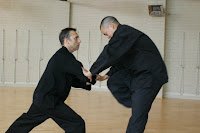Internal arts and pushing

I have previously highlighted my disdain for "mystical" interpretations of the internal martial arts. In my view all martial arts function within the bounds of known physics; there is simply nothing metaphysical - nothing that is left wanting for a "paranormal" explanation. However there are still many people out there who adhere to the opposite view. To quote a correspondent on an internet forum: "My view of internal martial arts is when the strike's power is so refined and seemingly defies physical laws. Where there is a transfer of energy enough to lift someone off their feet yet have very little to no body momentum to justify the result of the strike." And there's the rub: "lifting someone off their feet"... What I want to know is, why do so many people who see themselves as "internal artists" think that pushing is a good measure of martial skill - or applied force, for that matter? Typically, these internal artists will ...

